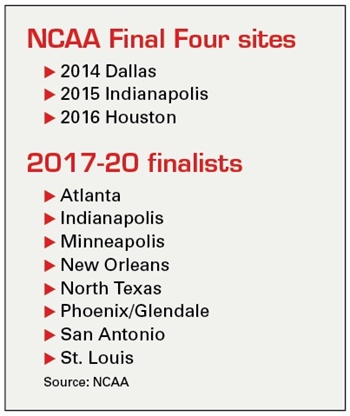Later this year, the NCAA will select future sites for the Final Four from 2017 through 2020.
Of the eight venues that are finalists for those four spots, most have hosted previous Final Fours or tournament regionals, meaning that the NCAA has a good idea of what to expect.
But how does the NCAA evaluate sites like Atlanta and Minneapolis, both of which will have new domed stadiums by then? Or San Antonio’s Alamodome, which has not been the site for a Final Four since 2008, the year before the NCAA started putting the basketball court in the middle of the football field and building out temporary seating?
The NCAA has turned to the Colonnade Group, a Birmingham, Ala.-based event business, to assist it in evaluating seating, capacity and various costs for each site.
Colonnade has worked with the NCAA since the late 1990s, about the time the NCAA went exclusively to domes for its flagship event. In the last decade, the NCAA established 60,000 as the minimum capacity for a Final Four.
Hitting that requirement won’t be a problem at AT&T Stadium, where a record Final Four crowd of 80,000 is expected in early April. Each year since the NCAA went to the “in the round” seating system, attendance for the championship game has topped 70,000. Last year’s game in Atlanta set the championship game record with 74,326.
But the Alamodome, for example, lists a capacity of 65,000. How could the NCAA be certain that its unique seating configuration wouldn’t alter that number?
“The seating system we use can fit in any stadium,” said L.J. Wright, the NCAA’s director of the men’s basketball championship. “There are seats, however, that are covered up when we build the temporary seating. All that must be taken into account.”
Colonnade uses laser measurements, blueprints and its own evaluations to determine how the seating system will fit into a stadium, even those in Atlanta and Minneapolis, which aren’t built yet.
A one-size-fits-all approach doesn’t work. Some stadiums are more oval, some are rectangular, and some, like AT&T Stadium, are not symmetrical at all, said Robbie Robertson, Colonnade’s president and CEO.
“They’re all somewhat similar, but none of them are the same,” Robertson said.
Working with Staging Concepts, the manufacturer that provides the risers and rails for the seating system, Colonnade builds the basketball court first and then the seats around it. The court sits on a stage that’s as high as it’s permitted to be — 29.5 inches. Code typically requires a railing at 30 inches.
From the sides of the rectangular stage, Colonnade then builds out press row and the temporary seats that will go across the edges of the football field, over the concrete wall and atop the permanent seats. Somewhere about a third or half of the way up the lower level, the temporary seats will be built to merge seamlessly with the permanent seats.
By the time it’s finished, the temporary seats look like they are a permanent part of the stadium.
Colonnade creates computerized seating diagrams that take every seat into account. That provides NCAA executives like Wright a visual image of a dome’s seating configuration when they are selecting sites.
Colonnade also builds in expenses for equipment, freight costs and labor.
Still, complications arise. During an installation at Reliant Stadium in Houston several years ago, a manager neglected to measure the size of the warehouse doors leading into the bowels of the stadium. Some of the seating equipment wouldn’t fit through the doors, which meant that it had to be altered. Precious hours were lost in the setup phase.
Those stories, however, have been few and far between, especially now that Colonnade’s team has set up the NCAA’s unique seating system in so many of the current domes.
“What happens is that you learn not to assume anything because you’re dealing with very tight specs,” Robertson said. “You know the old saying about assumptions. That definitely applies here.”




